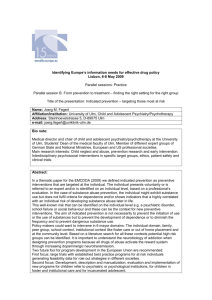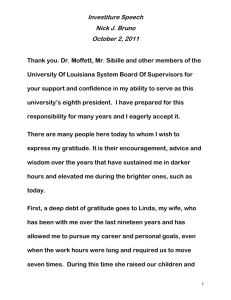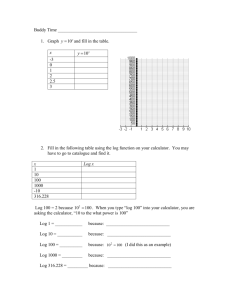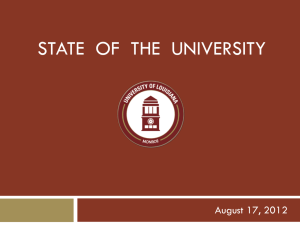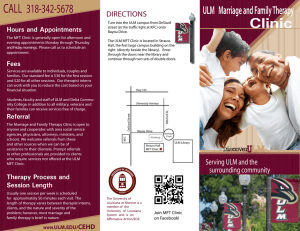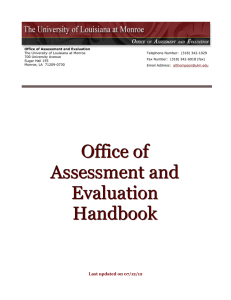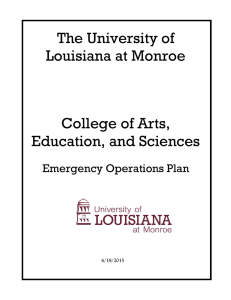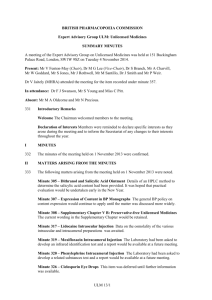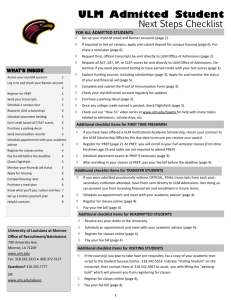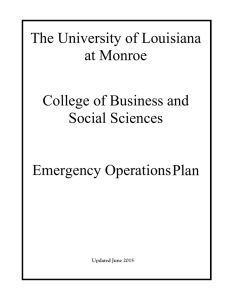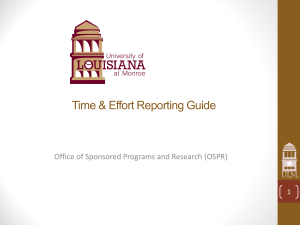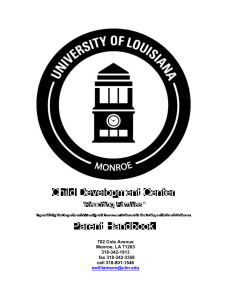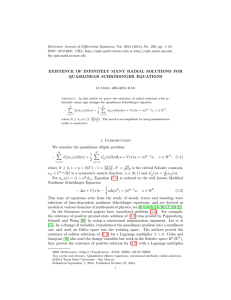Math 116 Elementary Statistics
advertisement
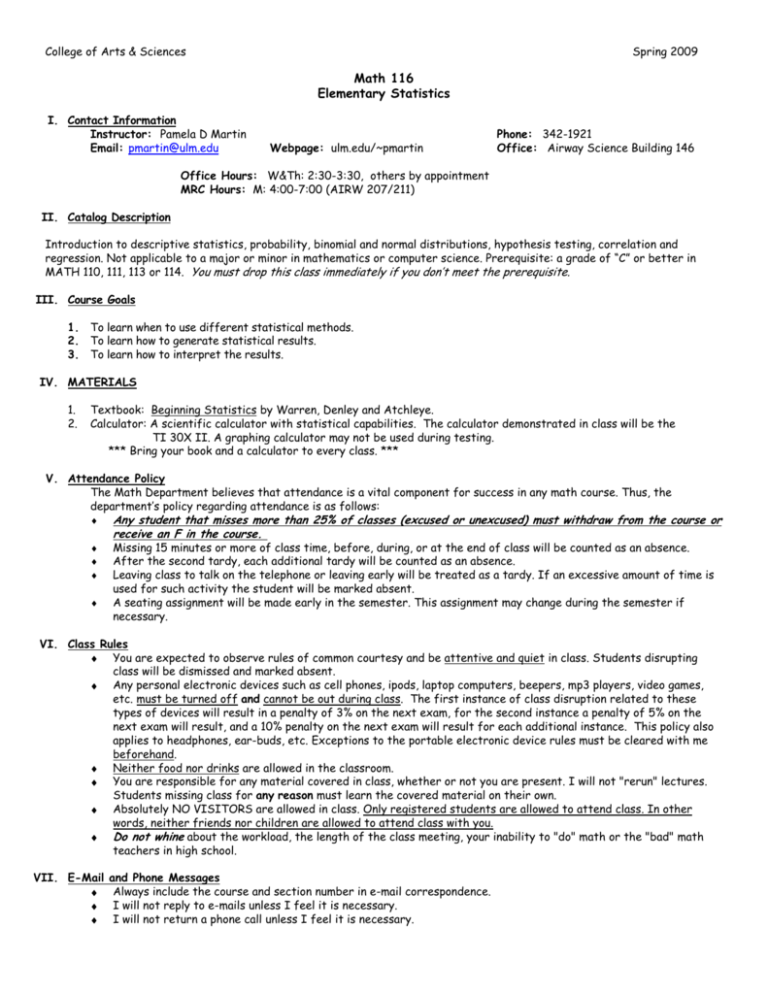
College of Arts & Sciences Spring 2009 Math 116 Elementary Statistics I. Contact Information Instructor: Pamela D Martin Email: pmartin@ulm.edu Webpage: ulm.edu/~pmartin Phone: 342-1921 Office: Airway Science Building 146 Office Hours: W&Th: 2:30-3:30, others by appointment MRC Hours: M: 4:00-7:00 (AIRW 207/211) II. Catalog Description Introduction to descriptive statistics, probability, binomial and normal distributions, hypothesis testing, correlation and regression. Not applicable to a major or minor in mathematics or computer science. Prerequisite: a grade of “C” or better in MATH 110, 111, 113 or 114. You must drop this class immediately if you don’t meet the prerequisite. III. Course Goals 1. To learn when to use different statistical methods. 2. To learn how to generate statistical results. 3. To learn how to interpret the results. IV. MATERIALS 1. 2. Textbook: Beginning Statistics by Warren, Denley and Atchleye. Calculator: A scientific calculator with statistical capabilities. The calculator demonstrated in class will be the TI 30X II. A graphing calculator may not be used during testing. *** Bring your book and a calculator to every class. *** V. Attendance Policy The Math Department believes that attendance is a vital component for success in any math course. Thus, the department’s policy regarding attendance is as follows: ♦ ♦ ♦ ♦ ♦ Any student that misses more than 25% of classes (excused or unexcused) must withdraw from the course or receive an F in the course. Missing 15 minutes or more of class time, before, during, or at the end of class will be counted as an absence. After the second tardy, each additional tardy will be counted as an absence. Leaving class to talk on the telephone or leaving early will be treated as a tardy. If an excessive amount of time is used for such activity the student will be marked absent. A seating assignment will be made early in the semester. This assignment may change during the semester if necessary. VI. Class Rules ♦ You are expected to observe rules of common courtesy and be attentive and quiet in class. Students disrupting class will be dismissed and marked absent. ♦ Any personal electronic devices such as cell phones, ipods, laptop computers, beepers, mp3 players, video games, etc. must be turned off and cannot be out during class. The first instance of class disruption related to these types of devices will result in a penalty of 3% on the next exam, for the second instance a penalty of 5% on the next exam will result, and a 10% penalty on the next exam will result for each additional instance. This policy also applies to headphones, ear-buds, etc. Exceptions to the portable electronic device rules must be cleared with me beforehand. ♦ Neither food nor drinks are allowed in the classroom. ♦ You are responsible for any material covered in class, whether or not you are present. I will not "rerun" lectures. Students missing class for any reason must learn the covered material on their own. ♦ Absolutely NO VISITORS are allowed in class. Only registered students are allowed to attend class. In other words, neither friends nor children are allowed to attend class with you. ♦ Do not whine about the workload, the length of the class meeting, your inability to "do" math or the "bad" math teachers in high school. VII. E-Mail and Phone Messages ♦ Always include the course and section number in e-mail correspondence. ♦ I will not reply to e-mails unless I feel it is necessary. ♦ I will not return a phone call unless I feel it is necessary. College of Arts & Sciences VIII. GRADING Spring 2009 Exam 1, 2, 3 20% each Comprehensive Final Exam 20% Graded assignments (Certify) 20% Semester grades will be assigned as follows... Percentage Final Grade* 90 - 100 80 - 89 70 - 79 60 - 69 0 - 60 A B C D F * To receive a “D” or better in the course a student must earn at least a 60% test average OR score at least a 70% on the comprehensive final exam Your mid-term grade gives an approximate indication of your performance on graded work up to that point. It does not necessarily represent fifty percent of your final grade. There is no guarantee that your final grade will be the same as your midterm grade. Undergraduate mid-term grades will be posted on-line for students to view via Arrow. Mid-term grades indicate a student’s status at mid-semester only and do not indicate the final performance outcome of a student. IX. Testing and assignments 9 All assignments are to be completed on computer. The details in class of how to use the computer will be given later. 9 All tests are to be taken on a classroom computer. Scratch paper will be provided. 9 You must bring your own calculator to the test. A graphing calculator may not be used during testing. There will be NO sharing of calculators and I will NOT loan you my calculator. 9 A missed test will receive a grade of '0' unless you present a VALID WRITTEN EXCUSE upon your return to class. 9 Students who will miss a test due to required participation in University activities should notify me prior to the test day. An appointment will be then scheduled for taking the test. 9 9 An Infirmary excuse is not considered a valid excuse for missing a test. All make-up tests will be scheduled at the instructor’s convenience. X. Academic Integrity: Students must observe the ULM published policy on Academic Dishonesty (see Page 4 in ULM Student Policy Manual -- http://www.ulm.edu/studentpolicy/). XI. Course Evaluation Policy: At a minimum, students are expected to complete on-line course evaluation. XII. Student Services: Information about ULM student services, such as Student Success Center (http://www.ulm.edu/cass/), Counseling Center(http://www.ulm.edu/counselingcenter/), Special Needs (http://www.ulm.edu/counselingcenter/special.htm), and Student Health Services, is available at the following Student Services web site http://www.ulm.edu/studentaffairs/. XIII. Emergency Procedures: Exit calmly and assemble as a class outside the nearest exit. College of Arts & Sciences Spring 2009 XIV. TENTATIVE* COURSE OUTLINE *The instructor reserves the right to adjust the schedule as needed. Ch. 3 4 5 6 7 8 9 10 11 12 Topics Numerical Descriptions of Data Probability Probability Distribution Continuous Random Variables Samples and Sampling Distributions Confidence Intervals and Sample Size Confidence Intervals for Two Samples Hypothesis Testing Hypothesis Testing (2 or more populations) Examining Relationships Text Sections or Pages 3.1, 3.2, 3.3 4.1, 4.2, 4.3, 4.4 5.1, 5.2, 5.3 6.1, 6.2, 6.3, 6.4, 6.5 7.1, 7.2, 7.3 8.2, 8.3, 8.4, 8.5 9.1, 9.2, 9.3 10.1, 10.2, 10.3 11.1, 11.2, 11.3 12.1, 12.2







